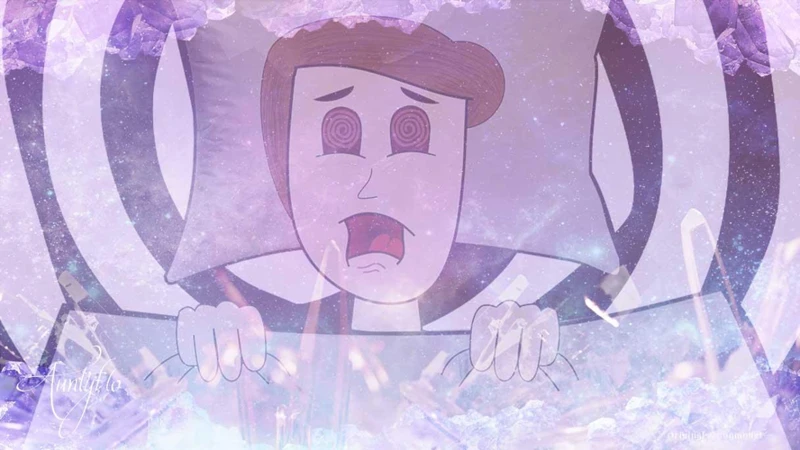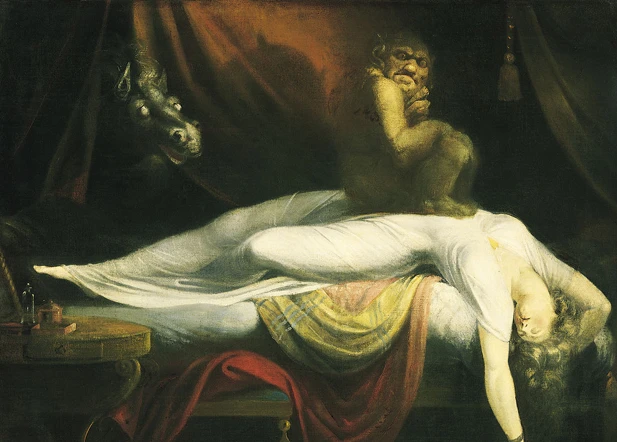Picture this: you find yourself in a state of complete immobility, engulfed in a sleep-induced paralysis that renders you unable to move, speak, or even scream for help. Your mind is fully awake, but your body remains trapped. This eerie phenomenon, known as sleep paralysis, has plagued countless individuals throughout history. From famous artists to composers and writers, the perplexing experience of sleep paralysis has left a profound impact on those who have encountered it. In this article, we will delve into the intriguing world of sleep paralysis, exploring famous cases and scientific explanations that attempt to shed light on this enigmatic occurrence.
The Mysterious Sleep Paralysis Phenomenon

Sleep paralysis is a perplexing and unsettling phenomenon that occurs when a person is temporarily unable to move or speak while falling asleep or waking up. It is often accompanied by vivid hallucinations and a sense of pressure on the chest, making it a truly disconcerting experience. The exact cause of sleep paralysis remains a mystery, although several theories have been proposed. One prominent theory suggests that sleep paralysis occurs when the brain transitions between REM (Rapid Eye Movement) sleep and wakefulness, causing a temporary disconnection between the brain and the body’s motor functions. Others believe that it may be linked to sleep disorders such as narcolepsy or disrupted sleep patterns. While sleep paralysis is generally harmless, it can be a frightening and distressing experience for those who endure it. If you’re experiencing sleep paralysis, it’s important to understand the signs and learn techniques for coping with it (/tips-coping-sleep-paralysis/). Additionally, scientists continue to explore the link between sleep paralysis and other sleep disorders (/link-between-sleep-paralysis-other-sleep-disorders/), as unraveling this mysterious phenomenon could offer valuable insights into the human brain and the nature of consciousness.
Famous Cases

1. Henry Fuseli’s Nightmare:
One of the most famous cases of sleep paralysis in history is depicted in the iconic painting “The Nightmare” by Henry Fuseli. Painted in 1781, the artwork portrays a woman lying on a bed, seemingly paralyzed, with a demonic figure sitting on her chest. This haunting image captures the essence of sleep paralysis, with the heavy weight on the chest and the presence of shadowy figures that often accompany the experience. Fuseli, himself, was said to have been inspired by his own encounters with sleep paralysis.
2. The Russian Composer Nikolai Rimsky-Korsakov:
Renowned Russian composer Nikolai Rimsky-Korsakov also had his share of encounters with sleep paralysis. In his autobiography, he describes terrifying episodes where he woke up unable to move while being tormented by hallucinations. These experiences influenced his compositions, notably in his opera “Sadko,” where he included a scene depicting a sleep paralysis episode. Rimsky-Korsakov’s vivid descriptions provide a glimpse into the psychological impact of this phenomenon on individuals.
3. The Painter Salvador Dali:
The surrealist painter Salvador Dali was well-known for his exploration of the subconscious and dreamscapes, which were strongly influenced by his experiences with sleep paralysis. Dali referred to sleep paralysis as “slumber with a key” and incorporated elements of it into his art. His famous painting “Dream Caused by the Flight of a Bee around a Pomegranate a Second Before Awakening” captures the eerie and distorted reality often associated with sleep paralysis, with surreal figures and strange perspectives.
These famous cases highlight the profound impact of sleep paralysis on creative individuals, serving as inspiration for their artistic expressions. They also shed light on the shared elements of sleep paralysis experiences, such as the sensation of being immobilized and the presence of hallucinations, helping individuals who have experienced sleep paralysis to feel understood and validated. To learn more about the signs and symptoms of sleep paralysis, please check our article on /sleep-paralysis-signs/.
1. Henry Fuseli’s Nightmare
1. Henry Fuseli’s Nightmare:
One of the most famous cases of sleep paralysis in history is that of the renowned Swiss painter, Henry Fuseli. In his iconic painting titled “The Nightmare,” Fuseli captured the essence of sleep paralysis with striking visual imagery. The painting depicts a woman lying in a deep slumber while an incubus, a malevolent spirit, sits atop her chest, rendering her immobile. This haunting portrayal perfectly encapsulates the sensation of sleep paralysis, with the feeling of weight and pressure on the chest being a common symptom experienced during episodes. Fuseli’s work not only showcases the artistic interpretation of sleep paralysis but also serves as a testament to the enduring impact that this phenomenon has had on individuals throughout history. The painting continues to captivate viewers and evoke a sense of unease, effectively conveying the enigmatic nature of sleep paralysis.
2. The Russian Composer Nikolai Rimsky-Korsakov
Nikolai Rimsky-Korsakov, the renowned Russian composer, was no stranger to the enigmatic world of sleep paralysis. In his memoirs, Rimsky-Korsakov documented his personal experiences with this haunting phenomenon. He described how during his episodes of sleep paralysis, he would find himself awake but utterly paralyzed, unable to move or make a sound. What made his encounters even more peculiar were the vivid and terrifying hallucinations that accompanied them. Rimsky-Korsakov vividly recalled seeing shadowy figures lurking in the corners of his room, whispering voices, and a strong sensation of being watched. These experiences left a lasting impression on the composer, inspiring him to capture their eerie essence in his compositions. Rimsky-Korsakov’s vivid descriptions of his sleep paralysis episodes serve as a testament to the deeply unsettling nature of this mysterious condition. His firsthand accounts contribute to our understanding of sleep paralysis as a truly perplexing and haunting phenomenon worthy of exploration.
3. The Painter Salvador Dali
The renowned surrealist painter, Salvador Dali, is not only known for his unconventional art but also for his vivid and eccentric dreams. It is said that Dali drew inspiration from his dreams, and sleep paralysis played a significant role in shaping his artistic vision. Dali described his experiences with sleep paralysis as a gateway to a world of hallucinations and surreal imagery. In fact, many of his famous artworks, such as “The Persistence of Memory” and “Dream Caused by the Flight of a Bee Around a Pomegranate a Second Before Awakening,” are believed to be influenced by his sleep paralysis episodes.
Dali’s descriptions of his sleep paralysis episodes are truly perplexing. He claimed to have felt a weight on his chest and the sensation of being surrounded by strange entities. Dali often incorporated these haunting figures into his artwork, depicting them with meticulous detail. His ability to translate the ethereal and bizarre sensations of sleep paralysis onto canvas captivated audiences and continues to intrigue art enthusiasts to this day.
For Dali, sleep paralysis served as a wellspring of creativity and fuel for his groundbreaking artistic expression. He once stated, “What is important is to spread confusion, not eliminate it.” His embrace of the mysterious and the unconventional in both his art and his personal experiences with sleep paralysis solidifies his status as one of history’s most enigmatic and imaginative artists.
Scientific Research and Explanations
Scientific research has made significant strides in unraveling the mysteries of sleep paralysis, offering explanations for this perplexing phenomenon. One prevailing theory revolves around the concept of REM sleep and its disruption. During REM sleep, the brain is highly active and dreaming occurs. To prevent acting out dreams, the brain sends signals to inhibit muscle movement. In cases of sleep paralysis, it is believed that these inhibitory signals persist even as the person begins to regain consciousness, resulting in a temporary state of immobility. Another explanation suggests that sleep paralysis may be linked to irregular sleep patterns, such as sleep deprivation or insomnia, which can disrupt the normal sleep-wake cycle. Stress and anxiety are also factors that have been associated with sleep paralysis, as they can affect sleep quality and contribute to the occurrence of these episodes. While these explanations provide valuable insights, there is still much to be discovered about the intricate workings of sleep paralysis and its underlying mechanisms. Nevertheless, continued scientific research brings us closer to understanding this enigmatic phenomenon and offers hope for improved treatments and management strategies.
Conclusion
In conclusion, sleep paralysis remains an intriguing and enigmatic phenomenon that has captivated individuals across history. From artists like Henry Fuseli and Salvador Dali to composers like Nikolai Rimsky-Korsakov, the experience of sleep paralysis has left an indelible mark on the creative minds of these individuals. While scientific research has shed some light on the mechanisms behind sleep paralysis, there is still much to be discovered. The mystery surrounding this phenomenon continues to fascinate and perplex both scientists and those who have experienced it firsthand. As our understanding of sleep and consciousness deepens, it is likely that we will gain further insights into the intricate workings of the human brain and the complexities of the sleep paralysis phenomenon. Until then, those who encounter sleep paralysis will continue to navigate its eerie confines with curiosity and a touch of trepidation.
Frequently Asked Questions
1. Can sleep paralysis be dangerous?
No, sleep paralysis is generally not dangerous. Although it may be a distressing experience, it does not cause any physical harm.
2. How common is sleep paralysis?
Sleep paralysis is more common than you might think. It affects approximately 8% of the general population, with higher prevalence among individuals with sleep disorders.
3. Can sleep paralysis be prevented?
While there is no foolproof way to prevent sleep paralysis, maintaining a regular sleep schedule, managing stress levels, and practicing good sleep hygiene may reduce the likelihood of experiencing episodes.
4. Are hallucinations during sleep paralysis normal?
Yes, hallucinations are a common occurrence during sleep paralysis. These vivid and often unsettling experiences can range from seeing shadowy figures to hearing strange sounds or voices.
5. Can sleep paralysis occur during naps?
Yes, sleep paralysis can occur during daytime naps as well. It is not limited to nighttime sleep and can happen during any sleep episode.
6. Is sleep paralysis linked to mental health conditions?
There is a correlation between sleep paralysis and certain mental health conditions such as anxiety and depression. However, more research is needed to fully understand the relationship between the two.
7. Can medication help with sleep paralysis?
While there is no specific medication to treat sleep paralysis, addressing underlying sleep disorders such as narcolepsy or improving overall sleep quality may help reduce the frequency of episodes.
8. Can alcohol or drug use trigger sleep paralysis?
Alcohol and drug use can potentially disrupt sleep patterns and increase the likelihood of experiencing sleep paralysis. It is best to avoid substances that may interfere with healthy sleep.
9. Can children experience sleep paralysis?
Yes, sleep paralysis can occur in children, although it is less common compared to adults. The exact prevalence among children is not well-established.
10. Is sleep paralysis a life-long condition?
Sleep paralysis is often a temporary or sporadic condition that may occur at different points in a person’s life. It is not necessarily a life-long condition, but some individuals may experience it more frequently than others.








